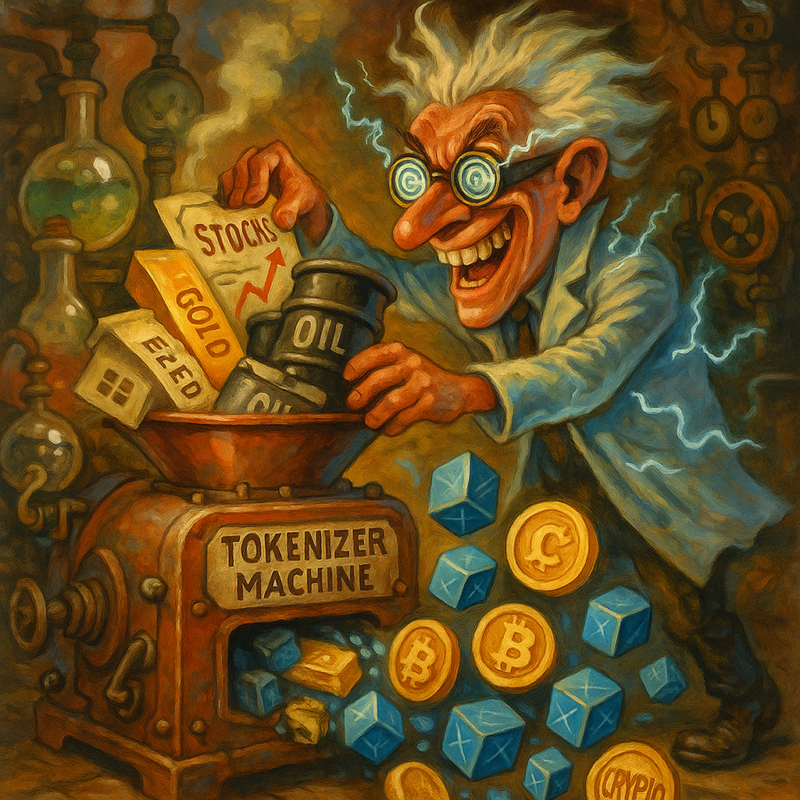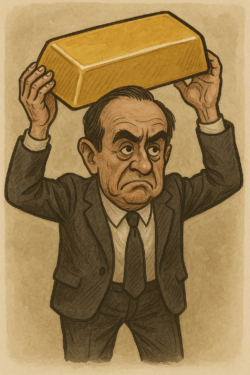Publisher’s Note: I know—at first glance, this might sound like another crypto curiosity. But what you’re about to read has far bigger implications.
It’s not just about gold, or Bitcoin. It’s about what happens when the oldest store of value in history meets one of the most powerful digital networks ever built.
And while the example I’m focusing on is Canadian, the shift it signals is global—relevant whether you’re investing from London, Leeds, or anywhere in between.
This is a glimpse of where things are heading. Quietly. Quickly. And for those paying attention, early.
“Gold is a rock. A shiny rock. That’s it.”
“It’s not scarce. It’s just heavy and useless.”
“I can’t buy coffee with gold. I can’t email gold. I can’t even see the gold I supposedly own in ETFs.”
These are all things I’ve said about gold in the past. I don’t usually get a lot of love from gold bugs.
As you probably know…
I’ve been a long-time advocate for Bitcoin over gold, arguing that Bitcoin has:
- Greater portability
- Absolute scarcity (21 million cap)
- Built-in programmability
- No need for vaults, guards, or middlemen
BUT…
Now that someone’s putting real, physical gold onto Bitcoin’s blockchain… I’m intrigued.
Why? Because it fixes gold’s flaws by using Bitcoin’s strengths.
You get the cultural and historical trust of gold…
With the digital, decentralized, programmable nature of Bitcoin…
And none of the 9–5 trading windows, ETF fees, or broker middlemen.
Meet the Bitcoin Matador
This is exactly what my friend, Sunny Ray, founder of Matador, is doing.
And it’s not a gimmick.
They’ve partnered with the Royal Canadian Mint. They’ve already bought 64 BTC. And they want to be the MicroStrategy of Canada.
Why gold, though?
Here’s a stat that blew my mind: Indian women own more gold than the U.S. government.
People around the world still love gold. That’s not going away. It’s a real-world cultural trend.
Matador’s mission became obvious: digitize the oldest money in the world (gold) using the newest (Bitcoin).
Here’s what they’re doing:
They take 1kg of gold and break it into 1g pieces called “Grammys” (yes, like the awards).
They laser-etch each piece with unique serial numbers and crypto-native art by “Doomsday,” a legendary digital artist.
They take that same image+serial and inscribe it onto a SAT, or the smallest unit of Bitcoin.
That SAT becomes a digital mirror of the physical gold.
You can buy it. Sell it. Trade it 24/7. And even redeem the gold to your house.
They call it “printable gold art.”
And because you’re buying art linked to real gold, not a “security,” they’ve found a clever regulatory edge.
But this isn’t just about gold.
It’s a sneak peek at a much bigger wave…
The $1.4 Quadrillion Opportunity
There’s $1.4 quadrillion in financial assets in the world.
That’s everything: stocks, bonds, real estate, debt, gold, you name it.
And almost none of it trades 24/7.
Almost none of it is divisible, global, or frictionless.
Almost all of it is locked in walled gardens—brokerages, jurisdictions, regulations, and outdated systems.
Tokenization changes that. It’s the biggest use case for crypto that nobody is paying attention to yet.
And while most people still think crypto means “dog coins” and scams, BlackRock is already tokenizing Treasury bills, real estate, and soon… everything else.
Treasury Secretary Larry Fink called it a $10 trillion opportunity.
Kraken is rolling out stock trading.
Tether is quietly buying up billions in Treasuries.
Small-cap companies are pivoting to Solana strategies like it’s 2021 again.
Matador is going straight for gold and silver.
Even Trump (love him or hate him) is reportedly eyeing 1 million BTC for strategic reserves.
I’ve said it before and I’ll say it again: crypto’s final form isn’t some new Ponzi. It’s Wall Street, rebuilt.
And tokenization is the door.
So… What’s Next?
I asked Sunny what else might be coming. What gets tokenized after gold?
His answer is what I also suspected: everything.
But Matador’s focus right now is on precious metals—silver, copper, maybe even digitized mines.
I told Sunny he should build a platform to let anyone tokenize anything—your house, your Rolex, your baseball card collection.
His response?
“We’re already building it.”
Best,

James Altucher
Contributing Editor, Investor’s Daily
P.S. When I first backed Bitcoin, people said I was crazy. Now we’re watching the tokenization of gold, real estate, stocks—even government bonds. This isn’t a trend. It’s the beginning of the biggest financial upgrade in history. I call it AI 2.0—and it’s quietly opening a rare Wealth Window. If you missed the early internet or crypto booms, this could be your second shot. Don’t waste it.
Invitation to Larceny
Bill Bonner, from the ranch at Gualfin, Salta Province
Another day. Another whiny intellectual who tells us we need to throw capitalism overboard.
Here’s a nutty opinion piece from Newsweek:
Capitalism Isn’t Working for the Poor. Let’s Try Something Else.
There are two parts to the above headline. Both of them are absurd.
First, how do they know ‘capitalism isn’t working for the poor?’ We’d say that whatever system we have has done a fair job of making the poor poor…and keeping them that way.
But it has also made America’s poor richer — in material terms — than the richest people of generations past. What Pharaoh had air-conditioning? Did Louis 14th or Madame de Pompadour get to watch TV or get pizzas delivered to their front doors? Did King Midas get anaesthesia when his teeth were pulled?
Napoleon didn’t even have central heating. John D. Rockefeller didn’t have the internet. Genghis Khan didn’t have running hot water.
Capitalism made these improvements. To be more precise, they were almost all made by the White Patriarchy. Yes, you can blame white men for the world’s ills. But when it came to plumbing and internal combustion engines, white men were on the ball. And not a single one of them was carrying out a government policy.
In America today, it is no longer easy to be genuinely poor. Who wants to live without a working HVAC? Who wants to carry water from a nearby stream… or keep a fire going in the winter months?
And few poor people today have a lean and hungry look. A much bigger risk is obesity, diabetes, and immobility.
Over many thousands of years, humans probably developed a deep preference for idleness. Hunting used up calories. And storing food was difficult, so there was no reason to kill more than you could eat. Nor were there any Rolex watches or giant mansions to prove your superior status.
The best you could do was to hunt and gather efficiently, so you were left with the most leisure time possible.
That taste for sloth, despite two thousand years of capitalism, is still with us. And today, most of America’s poor probably choose to be poor; after all, the path to not being poor is pretty well sign posted. All you have to do, statistically, is to get married and stay married…and get a job and keep it. Then, of course, make sure you spend less than you make.
Is that so hard?
Disagreeable and boring, perhaps. Keeping a job…like keeping a spouse… can be a real drag. But according to the labor department, there are more jobs on offer than there are people to take them. As for the marriage market, we don’t know…but we see people get married once… twice…even three times, so it can’t be that tough.
The poor people we’ve known danced to their own feckless tune. ‘Capitalism’ had little to do with it. But the success of capitalism makes it possible for a whole class of people — who might otherwise be foraging for food or standing in line to get a loaf of bread — to spend their time thinking about how to improve it.
That is where the second idiotic part comes into play. “Let’s try something else,” is an invitation to larceny. Either people do the best they can in a more-or-less honest economic system…or one group uses ‘politics’ to steal from another. There is no other ‘else’ to try.
You’d think the writer — Thomas C. Foley, former GOP candidate for governor of Connecticut — would know better. But he proposes a two-tier system… in which one group gets to go about its business as it chooses (the capitalists)… and the other group (the poor) gets free money:
At age 20, young Americans would choose whether they want to be in the free-market system or the stabilized income system. Enrollment in either system would be voluntary based on individual preference, subject to the maintenance of the roughly 70 percent to 30 percent workforce breakdown. Before age 30, workers would have the option of switching systems once. After 30, switching would be possible, but expensive. Each year the stabilized income amount would be adjusted for new entrants to keep the number of participants between 25 percent and 30 percent of the workforce.
Talk about being born yesterday. Mr. Foley must have just dropped from the womb. How many times and places have experimented with improvements to capitalism?
Just in our lifetimes we’ve seen the Soviet Union, Kampuchea, and North Korea…not to mention the many more modest improvements wrought by the Fed, the War on Poverty, trade policy, DEI programs and many others. How many successes are on this long list?
None!
But maybe this time…
Regards,

Bill Bonner
Contributing Editor, Investor’s Daily
For more from Bill Bonner, visit www.bonnerprivateresearch.com




